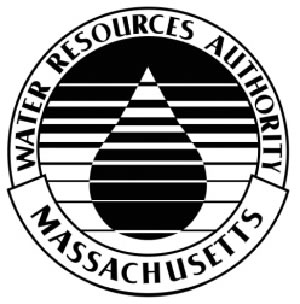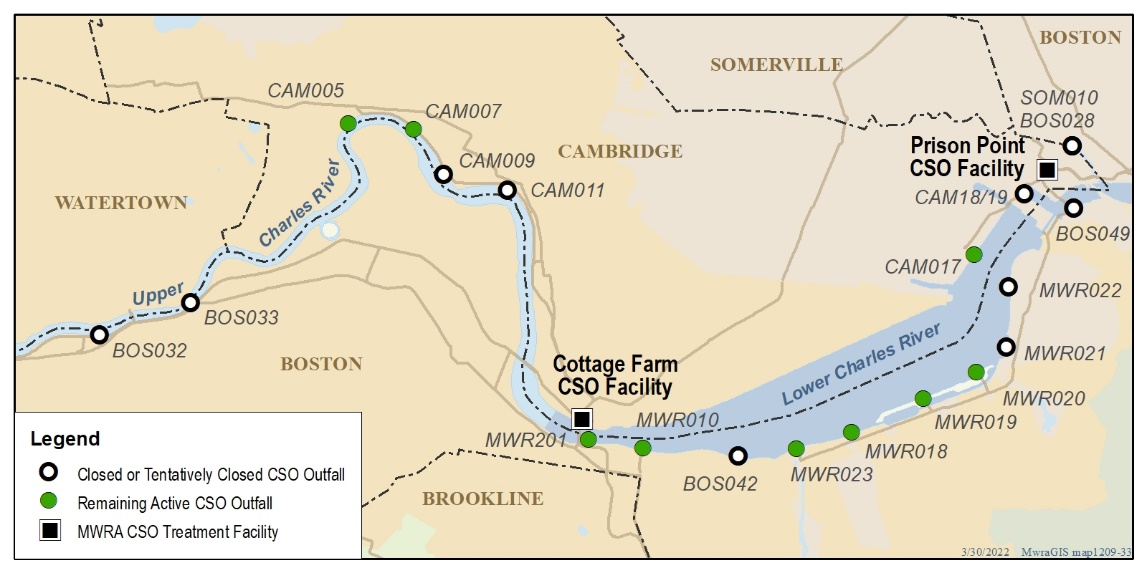In August 2019, the Massachusetts Department of Environmental Protection (DEP) issued, and the U.S. Environmental Protection Agency (EPA) subsequently approved, a Final Determination to Adopt a Variance for Combined Sewer Overflow Discharges to the Charles River Basin. The Variance is a short-term modification of the Massachusetts Water Quality Standards, which allows for limited combined sewer overflow (CSO) discharges from the outfalls along the Charles River Basin permitted to the Massachusetts Water Resources Authority (MWRA) and the City of Cambridge, subject to specific conditions. One of the conditions in the Variance requires the MWRA and the City of Cambridge to annually issue a press release, which includes: (1) general information on CSOs; (2) the location of outfalls in the Charles River watershed; and (3) potential health risks posed by exposure to CSO events. The MWRA and the City of Cambridge also provide herein an update on the progress of CSO control measures to improve the water quality of the Charles River Basin.
I. General Information
The water quality in the Charles River Basin (from the Watertown Dam to the Charles River Dam) can be impaired due to bacterial and other pollutants from a number of sources, including CSOs, cross connections between sanitary sewers and storm drains, stormwater runoff, and river flows from upstream of the Watertown Dam. According to the latest Charles River Report Card issued by the EPA, the Charles River received a B- for compliance with swimming and boating standards.
Contaminant sources that contribute to water quality impairment include CSO, stormwater and other discharges from communities along the Charles River Basin, including Boston and Cambridge, as well as stormwater and other discharges from communities along the Charles River upstream of the Watertown Dam. All of these communities are undertaking programs to identify and control sources of pollution to the Charles River. Portions of Boston and Cambridge are served by combined stormwater and sanitary sewer systems common in older cities. Six open CSO outfalls are permitted to the MWRA and three open CSO outfalls are permitted to the City of Cambridge in the Charles River Basin (see the map in Section II. below) and are designed to release CSO (a mixture of wastewater and stormwater) during heavy rainfall to provide critical relief to the sewer system when flows exceed system capacity. While these discharges can contribute to the impairment of water quality, they are necessary to prevent sewer backups into homes, businesses, and streets.
II. Location of Outfalls
III. Potential Human Health Risks
CSOs and contaminants that can get into separate stormwater pipes can include Microbial pathogens (i.e. bacteria, viruses, and parasites) and toxins (i.e. metals and synthetic organic chemicals). Some of the health risks associated with contact and ingestion of these discharges include: gastrointestinal illnesses, acute diarrhea, and skin irritation. Because of increased health risks associated with these contaminated discharges, public health officials recommend avoiding contact with the Charles River Basin during rain events and for a period of 48 hours following rainfall, as there may be increased health risks during these periods. Contact with floodwaters should also be avoided, as they may contain similar contaminants and pose associated health risks. Proper precautions are necessary to minimize these risks during flooding events. DEP has developed guidance for homeowners for responding to flooding onto your property from large storms or sewer backups, which can be found on the DEP website.
MWRA and Cambridge have implemented a system for rapid reporting of CSO discharges to the Charles River. These subscriber-based systems provide timely information regarding a CSO activation including the start time and location of the discharge. To subscribe, sign up at these links:
- Cambridge CSOs Subscriber: https://www.cambridgema.gov/Subscribe
- MWRA CSOs Subscriber: https://www.mwra.com/updates/everbridge/join.html
IV. MWRA and the City of Cambridge Actions to Address Charles River CSOs
As part of the 36-year old Federal District Court Order in the Boston Harbor Case (D. Mass. C.A. No. 85-0489-RGS), MWRA is required to undertake certain corrective actions to reduce or eliminate CSO discharges to Boston Harbor, the Mystic, Charles and Neponset Rivers and Alewife Brook. MWRA and its communities with permitted CSO outfalls, including Boston, Cambridge, Chelsea and Somerville, have been reducing CSO discharges since the 1980s. Major improvements to the regional wastewater collection and treatment system by MWRA, together with local system improvements by the communities, including the separation of combined sewers with construction of new storm drain systems, have contributed to the closing of many CSO outfalls and a 87% reduction in the total annual volume of CSO discharge region-wide during an average/typical year.
To date, 35 projects in the Long-Term CSO Control Plan (LTCP) approved by the U.S. Environmental Protection Agency (EPA) and DEP, and mandated in the federal court order, have been completed. In December 2021 MWRA submitted the Final Post Construction Monitoring and Performance Assessment report, which summarizes the results of CSO inspections, overflow metering, hydraulic modeling, system performance assessments and water quality assessments. Eight of the 35 projects have contributed to the control of CSO discharges to the Charles River. Together, these eight projects and other efforts by Boston Water and Sewer Commission and the City of Cambridge have closed five CSO outfalls and tentatively closed outfalls CAM009 and CAM011 (see the map in Section II), pending additional hydraulic evaluations by the City of Cambridge. MWRA and the communities have made great progress toward achieving the LTCP goals, which included reducing the average annual CSO volume to the Charlies River Basin from the 1988 level by 99.6%. As documented in MWRA’s December 2021 Final CSO Post Construction Monitoring and Assessment Report, the volume for an average/typical year has been reduced by 99.3%, (only 0.3% from the LTCP goals), of which 73% is treated. Recent water quality modeling has shown that at current levels of control, if only CSOs were discharging to the Charles, the water quality standard for E. coli bacteria would be achieved 99.6% of the time in an average year. However, the water quality is greatly reduced when including all other pollutant sources (predominantly stormwater and upstream bacterial contributions), resulting in water quality standard for E. coli being met to only 48% of the time in an average/typical year. Although substantial progress has been achieved in reducing the number of activations and volume of CSO discharged to the Charles River, the activation and/or volume goals established many years ago have not entirely been met at five of the nine remaining CSO outfalls. MWRA’s work to meet the LTCP goals continues under a 3-year extension to the Federal District Court Order and the Variance requirements. Annual reports will be provided on MWRA’s progress and a supplement to the December 2021 Final Performance Assessment report will be submitted by December 2024 on the 16 region wide CSO outfalls not currently meeting LTCP goals.
In accordance with the terms of the Variance, in December of 2022, MWRA completed and submitted the Alewife Brook and Charles River System Optimization Evaluations report. Optimization alternatives, including possible modifications to the structures in the combined sewer system, which can divert excessive flows during larger storm events to CSO outfalls (i.e., CSO regulator), were evaluated using the MWRA’s recently updated and calibrated hydraulic model. The intent was to ensure available conveyance capacity is fully utilized, while not causing conditions that could contribute to flooding or backups in the connected sewer systems. Of the nine remaining CSO outfalls along the Charles River, CAM005 was the only CSO outfall recommended for modifications, including raising and lengthening the existing weir wall in the regulator. This alternative is now being evaluated for constructability with the support of Cambridge. No optimization measures were recommended at the regulators connected to the seven other active untreated CSO outfalls along the Charles River. At these locations, increasing the weir height or regulator connection capacity resulted in unacceptable water surface conditions in the connecting sewers. Further operational adjustments to MWRA’s Cottage Farm CSO facility (MWR201) were also evaluated, but found to produce minimal reductions in CSO volume from MWR201. However, the work continues to further reduce or eliminate CSO to the Charles River. MWRA and Cambridge are each proceeding with developing separate CSO Control Plans for CSO outfalls owned by each agency that discharge to Variance waterbodies of the Alewife Brook/Upper Mystic and Charles River Basin. These CSO Control Plans will further analyze the costs, performance, and the impacts to water quality associated with additional CSO control alternatives, up to and including elimination of CSOs. Additional consideration will be given to the use of Green Infrastructure technologies and the impacts on Environmental Justice communities. MWRA and Cambridge will continue to partner in this effort.
For more information on CSOs and the CSO control program, visit MWRA’s and Cambridge’s websites at:
https://www.mwra.com/03sewer/html/sewcso.htm
https://www.cambridgema.gov/cso



